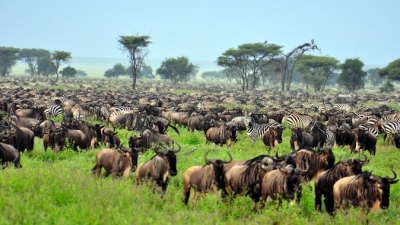
Located on the border between the African countries of Kenya and Tanzania, the Serengeti National Park in Tanzania’s Serengeti plain spans an area of nearly 15,000 sq.km. The grassland and woodland savannah of the region, interspersed with rivers, is home to several species of animals such as cheetah, wildebeest, and zebra, and the threatened black rhinoceros. Set up in 1951, the Park attracts tourists from across the globe throughout the year for not just its diverse wildlife but also for hosting one of the most significant land animal migrations. It is one of the largest and the most diverse places in the world to witness the coming together of a large number of predator and prey. The Serengeti National Park was declared a UNESCO World Heritage Site of “outstanding universal value in 1981.
Wildlife
In addition to carnivores such as lions, leopards, cheetahs, and crocodiles, and herbivores such as wildebeest, gazelles and zebras, one can spot wild dogs, topis, warthogs, antelopes, elephants, giraffes, African buffaloes, rhinoceroses, hippopotamuses, and baboons within the periphery of the Park. The Park also nurtures a few hundred species of both resident and visiting birds. They include ostriches, grebes, pelicans, cormorants, darters, bitterns, herons, egrets, storks, ibises, spoonbills, flamingoes, teals, ducks, geese, shovelers, pochards, vultures, harriers, eagles, hawks, kites, kestrels, falcons, quails, francolins, crakes, coots, moorhens, bustards, jacanas, snipes, sandpipers, plovers, terns, gulls, sandgrouses, doves, turacos, nightjars, swifts, kingfishers, bee-eaters, rollers, hoopoes, hornbills, barbets, woodpeckers, larks, swallows, martins, orioles, babblers, shrikes, robins, wheatears, warblers, flycatchers, pipits, weavers, starlings, and sunbirds.
Did you know?
- Every year, more than 10 lakh wildebeest, along with thousands of other herbivores and ungulates such as zebra and gazelle, go on a 1,000-km circuitous journey between the Park in Tanzania and Kenya’s Masai Mara Game Reserve. The migration sees the animals moving to greener pastures in Kenya during the dry season in Serengeti. Throughout the migration, several adults and newborns perish to predators such as crocodiles, lions, and cheetah, but much more survive to keep the world’s most astounding spectacle alive.
- The Park faces threats due to natural causes such as wildfires, and human-related issues such as excessive tourism, water management, poaching, etc. For instance, a recent study that had studied the region over a long period of time found that due to increasing human activity on the boundary, animals congregate increasingly in the core of the protected area. And this is not good news because such a concentration could lead to depletion of natural resources such as plant and water, and even lead to extreme drought.
- While the large numbers of animals migrating to the region is fantastic news, monitoring something of this magnitude requires a lot of time and labour. Recently, a “research team testing the capacity of both citizen scientists and machine learning algorithms to help survey the annual wildebeest migration in Serengeti National Park in Tanzania found that both methods could produce accurate animal counts, a boon for park managers”.
- African wild dogs disappeared from the Park around 1991-1992, and several reasons-from rabies and canine distemper diseases to encroachment of farming activity into their habitats have been attributed to the disappearance. Around 2012, a few packs were re-introduced to the region, and some of them even gave birth to young ones.
Picture Credit : Google



